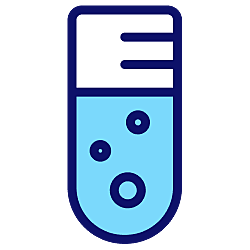Home STI Test Kits
Test yourself for a sexually transmitted infection (STI) without visiting a GP or clinic. Use our fast, confidential, and convenient home testing service. All test kits are available with free standard delivery.
Prices from £29.99
Order your kit, carry out your test, and send your sample to our UK accredited partner laboratory.
Getting tested for sexually transmitted infections (STIs) is now easier. You can request home test kits for a wide range of STIs with ZAVA, including:
- chlamydia
- gonorrhoea
- syphilis
- genital herpes
- trichomoniasis
- HPV
We also offer testing for bloodborne STIs. This includes HIV testing and tests for hepatitis B and C.
Why test with us?
- Fast, reliable results: test kits are delivered to your doorstep with free next day delivery. Get results within 48 to 72 hours of Royal Mail receiving your test sample.
- No GP or clinic visits needed. Carry out a simple test at home. If you have questions, you can privately message our doctors or Patient Care team through your account.
- 100% confidential. Results are sent to your secure online account along with advice from one of our qualified doctors.
Select an STI test kit
In stock. Prices from £135.99
In stock. Prices from £35.99
In stock. Prices from £30.99
In stock. Prices from £79.99
In stock. Prices from £35.99
In stock. Prices from £29.99
In stock. Prices from £49.99
In stock. Prices from £34.99
In stock. Prices from £34.99
In stock. Prices from £74.99
In stock. Prices from £124.99
In stock. Prices from £124.99

In stock. Prices from £49.99

No results found.
Please check your spelling or try another treatment name.



About STI testing
-
-
You can get an STI test at any sexual health clinic or from an online doctor service, like ZAVA.
There are a few different types of tests available for STIs, including:
- urine tests
- swab tests
- blood tests
You may also be asked to have a physical examination at a clinic. This is where the doctor or nurse will check your genitals to see if there are any visual signs of an STI.
The clinic will then advise you on how you’ll receive the test results and any appropriate treatment needed.
You might feel embarrassed when going to a sexual health clinic, but there’s no need! The staff are trained to deal with all types of infections and will always keep your information confidential.
If you prefer to do an STI test at home, you can request a home test kit from ZAVA. Our test kits contain all the materials you’ll need for a sample, so you do not need to visit a clinic. You can post the sample from any UK postbox and get your results via your secure and confidential ZAVA account.
We have a range of different test kits to check for various STIs. If you want to check for a specific STI, you can request a single test kit. For example, we have test kits for chlamydia, genital herpes, and syphilis.
You may choose to do these single tests if you think you’ve been exposed to a particular STI. This might happen if you have unprotected sex with someone with a confirmed STI status.
You can also request our more comprehensive test kits, including:
- bloodborne STI test (including HIV and hepatitis B and C)
- extended STI test kit
- full female test kit
These test kits will take several samples to check for a range of different STIs.
-
-
It’s best to get an STI test whenever you change sexual partners. You can also get a full STI test every year as part of an annual check up.
You should do an STI test if you think you’ve been exposed to an STI during unprotected sex. This can happen if you know your partner is positive for an STI or if their STI status is unknown.
-
-
An at home STI test kit will contain all the materials you need to do the test. Using the test kit will depend on what samples you need to provide.
If you need to give a blood sample, the test kit will contain devices called lancets. Lancets have a small needle that pricks your finger to cause a small amount of blood to come out. You’ll need to fill a small sample tube up with your blood. The pinprick will heal very quickly and will not leave a scar.
A swab test will require you to swab your genitals or the affected area with a long swab, similar to a cotton bud. You’ll keep the swab in a sealed container once the sample is complete.
A urine sample test kit will come with 2 separate pots. You’ll need to capture your urine in the smaller sample pot and securely seal it into the larger pot.
You’ll be asked to post your sample in a pre-paid envelope to our lab partner.
Not all STI tests will require each type of sample. With some test kits you’ll only need to do a swab test, like with genital herpes. Comprehensive test kits may ask you to provide several samples to check for different STIs.
At ZAVA, all our home test kit samples are sent to our accredited lab partner. This is the same lab that provides testing for the NHS and other clinical providers.
-
-
Home STI test kits are as accurate as the tests you do in a clinic. As long as you follow the instructions when taking your sample, your results can be up to 99% accurate (depending on what type of test it is).
If you have problems getting your sample, this can affect the accuracy of the test. Make sure you read the instructions carefully before trying to attempt a sample.
-
-
There are some differences between completing a home test kit that you’ve ordered online and getting tested at a clinic or surgery.
There are several advantages to carrying out a home test. For example:
- you don’t need to book or attend an appointment
- you don’t need to discuss your sexual health or sexual history with anyone face to face
- you can collect your sample in the comfort and privacy of your home
- you can contact our team if you have any questions or need help
-
-
It takes around 2 to 3 working days to get your test results back once the lab has received your sample. Your test result will be sent to your confidential ZAVA account. We will never share your test result with anyone, unless you ask us to.
-
-
If you test positive for an STI, our doctors will guide you through the next steps.
Many STIs are now treatable, especially if they’re caught early on. You can treat certain STIs with antibiotic or antiviral treatment, which is as simple as taking a tablet for a few days. This includes chlamydia treatment, trichomoniasis, and genital herpes.
If you test positive for HIV, we can guide you to contact the nearest specialist HIV clinic. You do not need a referral for this so you do not have to speak to your doctor if you don’t wish to.
-
-
If you’ve had unprotected sex and think you might have been exposed to an STI, you should wait at least 2 weeks before doing an STI test. This is because the level of virus or bacteria in your blood will not be high enough to detect immediately after sex.
For some STIs, like syphilis, you’ll need to wait at least 4 weeks before you can do a test.
For HIV, you need to wait at least 45 days before doing a test.
If you’re not sure when to do an STI test, speak to your sexual health clinic.
-
-
For certain STIs, you might need to do a follow up test.
If you test positive for HIV, you’ll need to do a follow up test. If the second test result is positive, this will confirm you have HIV.
For some STIs like chlamydia, it’s best to do a follow up test around 3 to 6 months after treatment.
If you are sexually active it’s better to get an STI test done every year, if not more often, to stay proactive about your sexual health.
-
-
Many STIs will not give you any symptoms. This means you might not realise you have an STI until months or years later. You can develop symptoms at any time after contracting an STI, which is not always immediate.
General symptoms of an STI can include having flu-like symptoms or feeling tired and worn down.
The symptoms of an STI in men can include:
- blisters or sores on your genitals or anus
- peeing more frequently
- pain when peeing
- pelvic pain
For women, STI symptoms can include:
- blisters or ulcers on your genitals or anus
- abnormal vaginal discharge
- vaginal bleeding
- pain or burning when you pee
- itchiness
These symptoms do not always mean you have an STI. If you think you might have been exposed to an STI, speak to your doctor or request a home test kit from ZAVA.
-
-
STIs are normally passed between people by unprotected sexual contact. This can include activities such as mutual masturbation with a partner and oral sex as well as sharing sex toys and penetrative sex.
Some STIs, such as HIV and hepatitis, can be passed through blood to blood transmission (for example, needle stick injuries or sharing needles).

Dr Babak Ashrafi Clinical Lead for Service Expansion
Accreditations: BSc, MBBS, MRCGP (2008)
Babak studied medicine at King’s College London and graduated in 2003, having also gained a bachelor’s degree in Physiology during his time there. He completed his general practice (GP) training in East London, where he worked for a number of years as a partner at a large inner-city GP practice. He completed the Royal College of GPs membership exam in 2007.
Meet our doctorsLast reviewed: 19 Jul 2022
-
Visiting an STI clinic (NHS) [Nov 2018] [accessed April 2022]
-
How long should I wait before I test? [Sept 2020] [accessed April 2022]
-
The services provided by the NHS for someone affected by HIV [Oct 2020] [accessed April 2022]

















